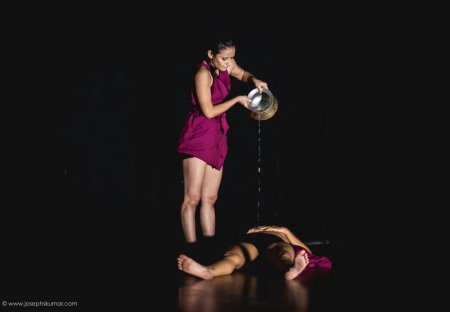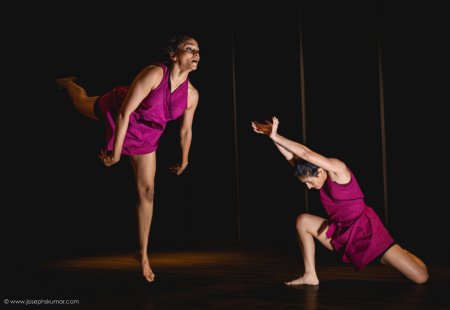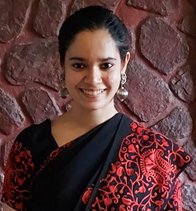
|   |

|   |
Revisiting of Bardo Beings - Rohee Uberoi e-mail: uberoirohee@gmail.com Photos: Joseph S Kumar September 2, 2022 Bardo Beings is a duet choreographed by Diya Naidu and performed by the contemporary dancers Ronita Mookerji and Diya herself. This piece was first devised in 2012, when the duo were company dancers and getting at it post their grueling company rehearsals the entire day. This duet was performed on 15th August 2022, at The Courtyard, Bangalore. Diya took inspiration for this work from personal anecdotes as well as images and practices described in The Tibetan Book of Living and Dying. An ode to the labor of their tired bodies, what began as a 20 minute piece, and remained untouched for a decade, has found its way back as a 50 minute journey of bold, outright and in the choreographer's words, "pulled open" rendition and revisit of the Bardo Beings. The audience's aural experience is further enhanced with the soundscape composed by Nikhil Nagraj, and voiceovers lent by the dancers themselves. The narrative appears to be dwelling on the memories of the body, textures of their physicality and propositions as well as the images that attest to accumulated, civilisational time. As the audience is let in, the dancers are already positioned on top of each other, with binds so intricate that it prevents us from distinguishing one from the other. This installation alludes to a single entity, a body as though still in its slumber; the cold temperatures of the room do nothing but add to this silence, visually broken after a couple of breaths. A hand from underneath crawling out and briskly receded, almost sets the tone for what is to come next. Further on, we realize that touch and glances are pivotal modes of communication here. Crawling, creeping, dabbing, tracing, caressing, scratching, tugging, pulling, pushing exhibits care, seduction, investigation, caution and fear. The bodies, as they begin to pull apart, show reluctance, to resist or insist on what the other proposes. The dancers already play, deceive the audience and each other; they create suspense and mystery be it the moment that they are intertwined, or when we notice the golden pot in a corner upstage. The pot instills curiosity and when introduced eventually, is extremely instrumental in driving the narrative and the mannerisms of the dancing bodies.  The merging and dissolving bodies traverse through eye-catching, sometimes provoking, at times overpowering visuals. This work tends to render images indelible amidst chaos and calm. The dancers balance, suspend and cling to each other to hold pauses. These images inspire and perhaps spill over from or into movement patterns. Them carrying each other in an awkward lock of the palm that lifts from the tailbones or scanning the audience in sassy postures, phrases suggestive of womb, Diya carrying Ronita, careful as she trudges, almost as though a part of a procession, performing rites, speaks a lot about dependency, cooperation, challenge and shifting dominance. Instances such as Diya lifting Ronita's dress to dab and trace her spine as she sits facing her back, crept up on its viewers. The finale is where Diya, with untied robes, lies on the floor and Ronita circumambulates around her, pours water, and sits on top of her to meditate. The lights dim in that moment and its solemnity further compels us to reason, whether Ronita impersonates death between the two, or is she dying as well, befitting to the title of "Bardo" or transitional. Intuition and imagination, suggested as driving forces do end up materializing in their use of space and choreographic tools. Despite the framework at hand, certain impulses that are given and received seem to be anticipated, while certain reflexes work as organic response to an action- for instance, Diya and Ronita gasping for breath after they tire themselves out while holding the pot with their mouth or Diya blinking when she is charged at, by Ronita. The juxtaposition of bodies placed at foreground and background, or the inter-positioning of certain body parts, as they hide, or suddenly appear, flavors temporality, embellishes the narrative, the dancers' character traits and the overarching sense of surprise and curiosity. This sense of shared time and supreme understanding between each other allows the dancers to work with casual as well as unnatural, beastly or contorted forms - be it when either of them take a peek at the other, or when Diya tumbles onto Ronita to make a two-sided creature. The occasional negligence of frontality, the trajectories of diagonals, curves and edges enhance sharpness and lull and help us see what inspires them.  Raw gestures are interspersed with stylised, seamless movements that unpack bursts of energy, add dynamism and functional value to the movement-scape. There is stillness, which grows into vigorous movements or to shake, as though to hold and further release. While I missed stillness on certain occasions, so as to be able to absorb all that might be fleeting, this movement design perhaps works to attain a hypnotic state and intensify the energy of the piece. A language of motifs, habits develops with stopping and waving, hooking the finger, opening jaws and screeching (animal-like calling unique to both). Ronita tries to strangle Diya while Diya finds ways to subdue or further manipulate her, as though she foresees what they are to encounter. These are conversations and fights that gradually transform from animalistic demeanours (where touch is paramount), to more civilized, ornamental and sophisticated martial persona, with a tinge of crudeness. Repetitions, emulating one another and the act of revisiting are essential to challenge linearity and celebrate chaos. In exploring one such diagonal where Diya is throwing herself into leaps and falls and Ronita is stealthily advancing towards her with the golden pot in her hand, the materiality or density of the water holding pot gets revealed to us. This water gets sprinkled, to tame or transition into different realms and states of physicality, splashed on oneself as a cleanser and ultimately poured around and over Diya's hot, trembling chest as a symbol of bidding farewell or surrender. The initial silence in the piece gave room for the audience to listen to the dancers slide, thump and scrape against the floor and each other. Somehow, I felt that the music, (although powerful in itself) while it anchored the performers by giving cues, compromised a bit on this act of the audience listening to the bodies and fully experiencing their largeness. The light setup was simple in this intimate space- a flood light placed at center, downstage and other studio lights partially lit at the staging area. This setting seemed to cooperate with how the dancers played and painted the scenarios using dimness and illumination. As they wore the same red robes as 12 years ago, one could say that this old fabric retained old memories, nurtured new bodies and stood witness to a generation of experience and evolution. It was quite noticeable that a shared responsibility had only fostered through the process for Diya and Ronita. The bodies of the dancers carried years of refinement and trust in their practice. Hence, it was possible to witness an approach to creation and execution that had settled, but was teased and tweaked, even made esoteric from time to time. Both artists use speech in their other works- in Bardo Beings, the choice of using voice-overs and not using voice at all, perhaps to stay committed to their task, could be seen as a fitting one. "The first breath being the last", "Death being the kind mother to us all", mourning, muffled voices, failure to speak, uncertainty of someone's death- such were the poetic echoes of Bardo Beings, lingering with the audience even after the performance. Diya and Ronita, as though confessing during the artist talk, shared how this journey would take a different route, each time and how power hierarchies would shift, sometimes leaving them disembodied, at times without a closure for their quest.  Rohee is a contemporary dancer based in Bangalore. She completed her diploma in movement arts from Attakkalari Centre for Movement Arts, Bangalore and continues to train in Bharatanatyam. Rohee is keen on learning and exploring performance, film, pedagogy and writing practices based on dance. |